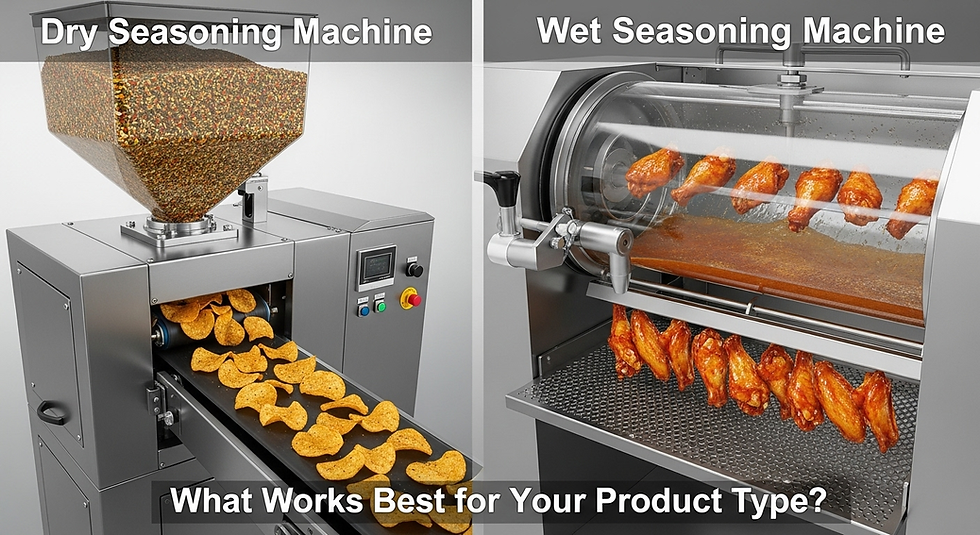Dry vs Wet Seasoning Machines: What Works Best for Your Product Type
- Feng De
- Sep 26
- 6 min read

Seasoning is a crucial step in many food manufacturing lines. Whether you’re working with snacks, nuts, chips, extruded pellets, meat products, or powders, choosing the right seasoning machine can make or break product consistency, waste rates, flavor delivery, and cost control. One of the major decisions you will face is: dry seasoning or wet seasoning?
In this blog, I’ll walk you through what dry and wet seasoning machines are, their advantages and challenges, and how to decide which is best for your particular product type. I’ll also share tips to choose a reliable supplier so you get the performance, flexibility, and longevity your operations demand.
What Are Dry and Wet Seasoning Machines?
Dry Seasoning Machines
A dry seasoning machine applies powdered ingredients, salt, powdered flavors, spice powders, dehydrated herbs onto a dry substrate (chips, popcorn, nuts, baked snacks, etc.). The machine usually has a rotor, tumbling drum, spiral agitator, or vibratory system that helps powders adhere uniformly by mechanical action or electrostatic assistance.
Because no liquids are introduced, dry seasoning is generally used when the product surface is already slightly tacky (from oil, fat, or moisture) or when the product itself can help bind powders.
Wet Seasoning Machines
A wet seasoning machine introduces a liquid or semi-liquid (binder, oil, water, flavor solution) along with the seasoning. The machine sprays or coats the product with a seasoning slurry or flavor solution, and then often passes it through a mixing zone, a drum, or tumble, and sometimes a drying stage.
Wet seasoning is common in foods needing strong flavor coating, sticky coatings (marinades, sugar glazes), or where flavor requires some liquid medium to bind to the product.
Advantages & Challenges: Dry vs Wet
Below is a comparative look at what makes each system strong and what pitfalls they bring.
Dry Seasoning: Strengths
Less moisture risk Since no liquid is added, the product is less likely to get soggy or degrade shelf life due to moisture absorption.
Cleaner lines, easier cleanup Dry systems avoid drips, sticky residues, and fouling that often come with liquids.
Lower energy use No need for evaporation or post-drying, so machines consume less energy overall.
Simplicity The mechanical design is often simpler—dry seasoning equipment can be less complex, with fewer spray systems, pumps, or nozzles.
Suitability for powders & light coatings When seasoning is minor (light salt, flavored dust), dry seasoning is ideal.
Dry Seasoning: Challenges
Adhesion and stick rate Powder adhesion can be inconsistent. If the substrate isn’t sticky enough or is too smooth, powders may bounce off or remain loose.
Dust control & waste Poorly adhered particles may fall off in transport or packaging. Dust generation must be managed.
Limited capability for wet flavors or glazes You cannot apply a glaze, sauce, marinade, or liquid flavor effectively in dry systems.
Uniformity issues on irregular shapes Complex shapes may have zones where powders don’t reach or stick.
Wet Seasoning: Strengths
Stronger flavor delivery Liquids allow deeper flavor penetration and richer taste.
Better coating for sticky or glaze effects Products that need sauce, marinade, or sugar coatings require wet systems.
More uniform coverage The liquid helps transmit particles into crevices or uneven surfaces more reliably.
Flexibility in seasoning types You can change viscosity, binder type, concentration, enabling different textures or finishes.
Wet Seasoning: Challenges
Drying required After wet application, the product often must be dried or dehydrated to the acceptable moisture level, adding energy and equipment cost.
Line hygiene & cleaning Liquids lead to stickiness, fouling, clogging sprays or nozzles, microbial risk if not cleaned properly.
Higher capital & running cost Pumps, spray nozzles, drying systems introduce complexity, maintenance, and cost.
Potential for moisture damage If overdone, the wet coating can degrade the product, reduce crispness, or shorten shelf life.
Choosing Based on Product Type
Which seasoning approach works best depends heavily on your product. Here are guidelines by product type to help you decide.
Snacks, Chips, Nuts & Crackers
These products often already contain some oil or fat from frying or baking. That residual surface tackiness helps powders adhere well. Therefore:
Dry seasoning is often preferred for light or powdered flavor coatings (salt, fine spice dust)
For heavier flavors, coatings, or sticky glazes (e.g. barbecue sauce, honey glaze), a wet seasoning system followed by drying is better
Extruded Pellets & Savory Snacks
For extruded snacks (e.g. cheese puffs, corn sticks), surfaces are porous, allowing dry powders to stick. But for heavy flavorings (cheesy sauces, dips) or sticky coatings:
Use a hybrid: dry seasoning for base flavor + wet seasoning or spray coating for heavy flavor layers
Meat, Poultry, Seafood or Protein Snacks
These often need marinades, brines, or liquid injection. Dry seasoning alone is rarely sufficient.
Wet seasoning is more suitable for marinades or brine treatments
You may still finish with a dry powder layer for texture
Bakery & Confectionary Items
Cookies, flaky pastries, bars: often coatings or glazes are liquid-based.
Wet seasoning or glaze systems are common
Dry seasoning is used only when applying powdered sugar, cocoa, or light dusts after baking
Seasoning Powders & Mix Seasoning Packaging
If your business is manufacturing pure seasoning blends (not applying them to snacks), you might use dry blending systems rather than seasoning machines. But for seasoning machines that coat products:
Go dry for dust-type segments
Wet systems are unnecessary unless you intend to precoat, bind, or partial hydration
Decision Matrix: When to Choose Dry vs Wet
Here’s a quick decision matrix to help with your thinking:
Feature / Consideration | Prefer Dry Seasoning | Prefer Wet Seasoning |
Light powder coatings / dust | ✔ | |
Need for glazes, marinades, sauces | ✔ | |
Lower energy consumption | ✔ | |
Easier maintenance & hygiene | ✔ | |
Uniform flavor penetration | ✔ | |
Risk from moisture or sogginess | ✔ | |
Flexibility in flavor profiles | ✔ | |
Need for drying equipment | ✔ | |
High adhesion on smooth surfaces | ✔ | |
Simpler capital investment | ✔ |
If your product leans strongly toward seasoning with heavy flavor, sauces, or coatings, wet systems will likely be the better fit. If your goal is powdered dusts, crisp textures, and simplicity, dry is a safer bet.
Hybrid & Dual-Mode Systems
In modern lines, many manufacturers combine both approaches to balance benefits. A dual-mode or hybrid seasoning line might start with a dry application, then move into a wet spray or binder stage, and finally dry again.
This gives flexibility: for lighter flavors use dry only, for premium lines use full wet + dry coating. As a sourcing buyer, finding a supplier who supports hybrid systems gives you more options and future adaptability.
What Buyers Should Demand from Their Supplier
Whether you lean dry or wet, picking the right supplier is critical. Here’s what to demand:
Proven experience in your product type (snacks, meat, extruded, etc.)
Test results & demos — ask for sample runs with your actual product
Flexibility & modularity — ability to upgrade, add sprayers, switch between dry/wet modes
Spare parts & maintenance support — especially spray nozzles, pumps, rotor blades
Ease of cleaning — detachable parts, cleaning ports, CIP (clean-in-place) design for wet systems
Precision control & instrumentation — dosing accuracy, flow control, moisture sensors
Scalability & capacity — matching your growth trajectory
Material compatibility & corrosion resistance — especially for wet systems with acidic or seasoning liquids
Warranty & quality assurance — alignment of specs with actual performance
When you find a supplier who meets all those, your risk is much lower and your performance is higher.
If you want to review some candidate machines from credible suppliers, you might browse offerings from a trusted supplier to see what models and capabilities are available.
Tips for Implementation & Transition
Pilot testing is essential Don’t commit full scale before you test the machine on your actual product under real conditions (humidity, line speed, seasoning variation).
Sync line speed, seasoning, ancillaries Your machine, conveyor, dryers, enrobing lines must be balanced so food isn’t overexposed or under-seasoned.
Tune your seasoning formula for the method Sometimes you adjust solids, binder content, viscosity depending on whether you are applying dry or wet seasoning.
Plan cleaning and changeovers carefully In wet systems especially, leftover residues, clogging, microbial growth can be big issues. Design for fast changeovers and clean cycles.
Monitor quality continuously Use sensors or inline checks (weighing, visual, moisture) to ensure the seasoning remains within spec.
Train operators & maintenance staff Proper handling of nozzles, calibration, preventive maintenance is key to longevity and consistency.
Closing Thoughts
Choosing between dry and wet seasoning machines is not simply about cost or trend. It’s about matching the method to your product type, flavor goals, line constraints, and future flexibility. Dry seasoning fits many basic snacks or products with light flavor requirements. Wet seasoning is essential when you need coatings, glazes, or stronger flavor adhesion. Hybrid systems offer a best-of-both path.
As a buyer in this space, your value lies in asking the right questions, demanding proofs, and working with a seasoning machine supplier who can support your product evolution. Get that right and your seasoning line will deliver consistent flavor, lower waste, and higher customer satisfaction.



Comments